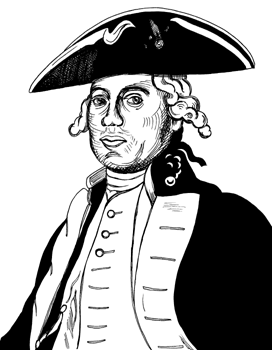 |
 |
|||
|
|
Admiral
Sir Edward Vernon was the fourth son of Henry Vernon (1663-1732) of Hilton,
Staffordshire, born on 30th October 1723. Richard Vernon (1726-1800), the
famous racehorse owner, was his younger brother. He should not be confused
with Admiral Edward Vernon (1684-1757) who belonged to a widely different
branch of the same family, their common ancestor in the male line having
lived in the time of Henry III, though an intermarriage in the time of
Charles I had brought them a little closer together. The
younger Edward Vernon entered the Royal Academy at Portsmouth in November
1735, where he continued for three years and three months. He was then
appointed as a volunteer per order to the ‘Portland’ with Captain John
Byng, whom he followed to the ‘Sunderland,’ one of the fleet off Cadiz
at the outbreak of the War of the Austrian Succession. In 1742, he was in
the ‘Sutherland’ in the Mediterranean under Rear-Admiral Nicholas
Haddock, and he passed his examination on 3rd March 1743. On 4th April, he
was promoted to be lieutenant of the ‘Granada’ sloop and, in June
1743, was appointed to the ‘Berwick’, then commissioned by Captain
Edward (afterwards Lord) Hawke, with whom he went out to the Mediterranean
and was present at the Battle of Toulon on 11th February 1744. On 5th
December 1747, he was promoted to be commander of the ‘Baltimore’ sloop
and, on 3rd April 1753, to be captain of the ‘Mermaid’. In May 1755, he
was appointed to the ‘Lyme’ of twenty guns, attached to the fleet in
the Bay of Biscay during 1755-6 when the Seven Years War began. He was then
sent out to the Mediterranean with Admiral Henry Osborn in 1757. In November
1758, he was moved into the 64-gun ship ‘St. Albans’, one of the fleet
with Admiral Edward Boscawen when he defeated and destroyed the French fleet
on 18th-19th August 1759. In 1760, he commanded the ‘Revenge’ under
Hawke or Boscawen in the Bay of Biscay. Sir
Edward had no further service in the navy, and retired to his home in Binfield,
Berkshire. However, in the spring and summer of 1785, he attracted some
further notoriety by making two balloon ascents from Tottenham Court Road,
the first time coming down in Horsham and, the second, in Colchester. He was
made a vice-admiral on 24th September 1787, admiral on 12th
April
1794, and died a few weeks later, on 16th June 1794. He was buried in Binfield
Church and his arrears of pay were paid to his widow, Dame Hannah,
who is not otherwise mentioned. Edited from Sidney Lee's 'Dictionary of National Biography' (1899).
|
|||
| © Nash Ford Publishing 2009. All Rights Reserved. | ||||



 Sir Edward Vernon (1723-1794)
Sir Edward Vernon (1723-1794)